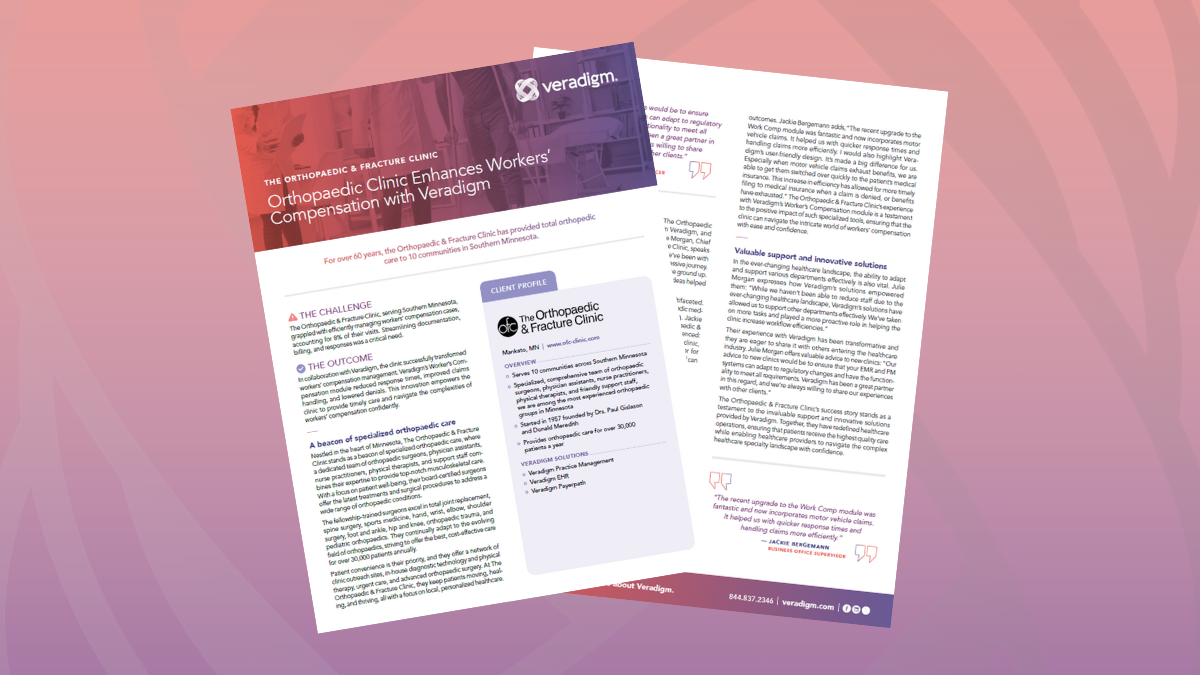The Orthopaedic & Fracture Clinic Transforms Workers’ Compensation Processes to Deliver Better Patient Care

Featured Client Story
Workers’ compensation is an important element of the healthcare system, particularly in orthopaedic medicine, as many occupational injuries involve the musculoskeletal system. As a result, nearly all orthopaedic surgeons include workers’ compensation cases among their patients.
However, dealing with the workers’ compensation system presents numerous challenges for orthopaedic surgeons and practices. When treating workers’ compensation patients, orthopaedic surgeons are not simply responsible for correctly diagnosing patient injuries and establishing appropriate treatment plans. They also need to understand the complexities of the workers’ compensation process: the forms to be filed, pre-authorization requirements, and the necessity for collaboration with patient employers, insurance companies, and legal representatives. Orthopedists must deal with worker’s compensation-related challenges ranging from payment delays and difficulties with the appeals process to the widely recognized correlation between workers’ compensation status, poorer clinical outcomes, and lower patient satisfaction levels.
These challenges have resulted in increasing difficulties obtaining referrals for orthopaedic practices that handle workers’ compensation patients. Many clinicians view workers’ compensation cases as too complex and time consuming. Meanwhile, studies show a 30% to 40% burnout rate among orthopaedic surgeons. A recent survey of U.S. orthopaedic surgeons revealed that their numbers are dropping—down 4.3% from 2020 to 2023. The American Academy of Orthopaedic Surgeons (AAOS) projects a 14% decrease in the number of orthopaedic surgeons by 2050, while a recent Physician’s Thrive report projects a deficit of 5,050 orthopaedic surgeons by 2025.
The Orthopaedic & Fracture Clinic, serving Southern Minnesota, is familiar with the numerous challenges of managing workers’ compensation cases. With a specialized, comprehensive team of orthopaedic surgeons, physical assistants, nurse practitioners, physical therapists, and support staff, the Clinic is one of Minnesota’s most experienced orthopaedic groups. The Clinic provides orthopaedic care for over 30,000 patients annually across 10 communities, and workers’ compensation cases account for 8% of the Clinic’s patient visits.
The Orthopaedic & Fracture Clinic needed to find ways to streamline the documentation, billing, and responses associated with workers’ compensation patients. They required solutions that would help them spend less time and energy managing the administrative tasks tied to workers’ compensation—enabling them to focus on providing top-notch musculoskeletal care to their patients.
Keep reading to learn how the Orthopaedic & Fracture Clinic collaborated with Veradigm to successfully transform their workers’ compensation management. Veradigm provided the Clinic with a suite of solutions tailored specifically to meet the unique needs of orthopaedic practices, including Veradigm EHR and Veradigm Practice Management. Utilization of Veradigm’s Worker’s Compensation module enabled the Clinic to improve its claims-handling process, reduce response times, and decrease associated denials.
This paper recounts how the synergy between the Orthopaedic & Fracture Clinic and Veradigm went beyond simply streamlining their processes to incorporate innovative solutions—solutions that enabled the Clinic to manage workers’ compensation cases more efficiently, yielding improved outcomes and benefiting both patients and their providers. These results included:
- Cleaner claims
- Minimization of denial rates
- Increased ability for Clinic staff to focus on patient care instead of administrative demands
Read the story of the successful collaboration between the Orthopaedic & Fracture Clinic and Veradigm, where Veradigm not only provides for the Clinic’s immediate technology needs but does so with the ongoing willingness to work with the Clinic and listen to their ideas and feedback. Together, they streamlined the Clinic’s healthcare operations, enabling the Clinic’s providers to focus on delivering prompt patient care of the highest quality in a complex specialty healthcare landscape.